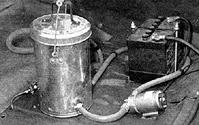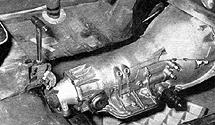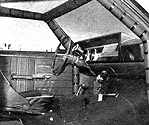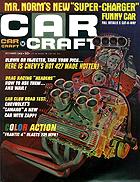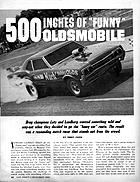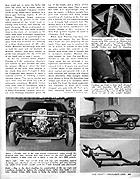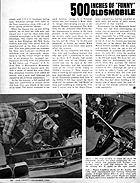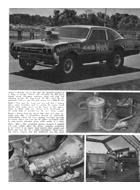 |
"Drag champions Lutz and
Lundberg wanted something wild and way-out when they decided to go the "funny
car" route. The result was a resounding match racer that stands out from the crowd." |
NOTICED LATELY THAT all the "funny cars" you see are either Ford
products, Chevys or Mopars? Two gentlemen racers from Minneapolis, Jim Lutz and Myron
Lundberg, spotted this situation and decided to do something about it, especially after
they flipped their record holding A/G Anglia. Jim and Myron voted that the "funny
car" route was the way to go rather than rebuilding the wrecked Anglia, since they
had won about everything possible with the gasser. Besides, the challenge of match racing
with something different in the way of a car appealed to the two veteran racers. They
agreed that since Tony Nancy had proven that the new Oldsmobile engine has competition
potential, why not build up a unique 442 Olds "funny car." They liked the idea
of an individualistic car that was easily identifiable from the "pack" and when
they approached Holiday Oldsmobile for a sponsorship, the Minneapolis agency decided to go
along for the ride with Lutz and Lundberg. Now Holiday Olds just happens to be the agency
which sold more 442's in 1965 than any other Olds dealer, and is going strong in 442 sales
in '66 to boot.
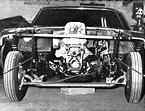 Frontal view of the Olds during
construction stages reveals the dropped tube axle, steering link, and braces for the steel
firewall and front fenders. A glass front end is slated to trim the car's 3000 pounds. Frontal view of the Olds during
construction stages reveals the dropped tube axle, steering link, and braces for the steel
firewall and front fenders. A glass front end is slated to trim the car's 3000 pounds. |
With a
sponsor behind them, Jim and Myron decided to let experienced Jack Wheeler do the engine
work. The finished product hardly resembled the stock 400 inched displacement engine with
which they started. The 1966 Olds block was bored .375 to accept a set of Forgedtrue
pistons with 7.5 to 1 compression ratio. Originally the boys planned to burn gasoline only
in the engine, but they knew that even if they used fuel they would need all the power
they could get to move the hefty 442 down the track. As a result, they ordered a Cranshaft
Company stroker crank as big inches are a necessity in a blown gas burning engine. A set
of Mickey Thompson forged aluminum rods connect the pistons to the crank which received
all the "trick" work including cross drilling, shotpeening, and hard chroming.
Many professional engine builders feel that these modifications to the crank are necessary
as the lower ends must withstand tremendous loads and forces in a supercharged engine. The
stroke of the Crankshaft Company crank was increased .375 resulting in a final
displacement of 496 cubic inches. Morraine 400 bearings were used on both the main and rod
journals. A Milodon "shorty" steel main support or girdle was strapped into the
lower end of the block just to keep it secure.
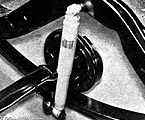
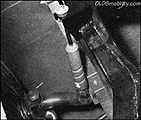
Left:
Immaculate trimmed stock Olds frame mounts early Olds rearend via elliptical leaf springs
and a set of Gabriel adjusted shock absorbers. Heavy duty Olds metallic brakes are used
for stopping. Right: Looking up front a four inch dropped tube axle mounting '48
Ford spindles is suspended by more full leaf springs and dampened by a set of 90-10 uplock
shocks to aid in the weight transfer. |
As for
the cylinder heads, Roger's Porting cc'd the combustion chambers and opened up and
polished the ports for greater effciency. After the head surfaces of the block were
parallel to the crank, they were O-ringed to keep the Fitzgerald head gaskets in place, a
common practice in building a supercharged engine. The valves, guides and valve seats were
left stock, but a set of adjustable aluminum Mondello rocker arms were used in conjunction
with a Crower billet roller cam and kit. A set of Sharp Equipment Company valve covers
with Stellings breathers grace the top of the heads, and a Sharp blower manifold was also
used. Then a modified GMC 6-71 supercharger was set atop the engine; a Hilborn upright
four port fuel injector and scoop topped everything off. Looking at the fuel system, a
Hilborn PG-150 pump was hooked to a Airoquip high pressure hose. The blower drive is a
Cragar unit with 16% overdrive, but future modifications will include change to 22%
overdrive. A Roto-Faze ignition supplies the spark to Champion J54R plugs.
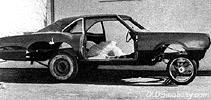
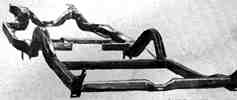
Top:
Side view reveals front and rear axle relocation, typical of funny cars. Rearend was moved
forward 17-inches and new opening cut, while front fender awaits work for 7-inch forward
axle placement. Bottom: Due to the short deadline for construction of the car, Lutz
and Lundberg decided to lighten the original frame rather than build a new tube chassis.
Clean Olds frame is hefty by today's weight standards. |
While
Jack Wheeler was busy constructing the engine, Jim and Myron didn't waste any time
preparing the car itself. Their goal was to construct the car as quickly as possible so
they could see some action this summer as the eastern drag strips close in October due to
inclement weather. Because they were pressed for time, Jim and Myron decided to use the
stock Oldsmobile frame although it was lightened considerably. An early Olds rearend with
4:30 gears was positioned 17-inches ahead of the location of the stock rearend and secured
with a set of fully elliptical left springs and Gabriel shock absorbers. Olds metallic
brakes were chosen to bring the American mag wheels and 10.50 x 15 Goodyear slicks to a
halt. Up front, the stock suspension was discarded in favor of a 4-inch dropped tube axle
with '48 Ford spindles, mounting more American mag wheels with 7.75 x 15 Goodyear racing
tires. Elliptical springs were used on the front suspension along with a set of 90-10
uplock hydraulic shocks.
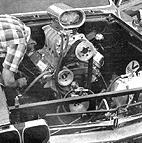
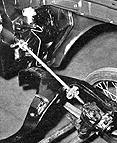
Top
Left: Myron Lundberg checks out the healthy 496 cubic inch supercharged fuel burning
Oldsmobile engine. A Cragar blower drive is used, along with Sharp manifold and valve
covers. Heads are ported by Roger, and Crower supplied the roller cam and kit. Top
Right: The boys decided to retain the stock '66 Oldsmobile steering box when
constructing the car, as it is reliable and performs well. Popular cross steering setup is
used; link connects the arm of the stering box to eyelet on the right spindle. |
When the
chassis was up and rolling around, the all steel 442 Olds body was slipped over it and the
wheel wells were relocated accordingly to fit the 105 inch wheelbase. The reason for the
heavy body is that fiberglass 442 Olds doors, fenders, and other body panels were not
manufactured at the time of construction. Now that glass parts are available for these
cars, Lutz and Lundberg are switching over to lightweight components to cut the overall
weight of their car in an attempt for increased performance. All body work was performed
by Bill Gefre, and "Peanuts" of N.E. Auto Body in Minneapolis, Minnesota,
applied the marron lacquer paint job, with a shade of ember fire mist. Dark blue
plexiglass windows were added all around, and a gold leaf lettering job completed the
external appearance.
As for
the interior, a full padded roll cage was constructed to protect driver Jim Lutz from any
injury in the event of an upset. The drive remained in the stock location, sitting in a
Triumph bucket seat, and actuates a Moon throttle linkage while keeping one eye on the
Stewart-Warner instruments. The shift lever for the reworked Olds Turbo-Hydramatic
transmission is located in the stock position, on the transmission tunnel to the driver's
right. Lutz steers the car with the stock wheel column, and steering box, and the release
for the Simpson parachute is within his reach. Black carpeting and stock inner door panels
offset the interior.
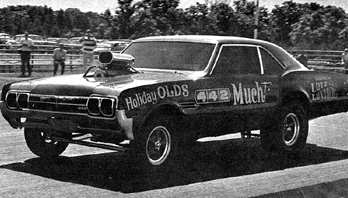
Above:
Moving out of the gate, the finished product is a thing of beauty. Wheel well reloaction
by Bill Gefre blends nicely. Plexiglass windows, paint and gold leaf lettering provide the
final touch. On 20% nitro the car pumped a 9.22 e.t. and 154 mph, strong for a 3000 lb.
rig. |
With the car
completed and ready to run, Lutz and Lundberg realized that they had quite a reputation to
live up to, as their A/G Anglia had nailed down both ends of the NHRA class record, had
won its class at the 1964 NHRA's Nationals, and had established itself as the overall
points champ in NHRA's Division V. They wasted no time in showing all concerned that their
new supercharged 442 could carry on, as the Oldsmobile grabbed both ends of the NHRA's
S/XS class record the third week out! At present the "442 Much" of Lutz and
Lundberg is leading the Division V points race in hot Super Eliminator competition, having
compiled almost twice the points of their closest competitor in that bracket.
Performance for the Minnesota based "funny car" has been encouraging, as initial
runs on gasoline produced a 9.79 elapsed time and a 148 mph clocking, quite respectable
for a 3000 pound race car. These marks placed "442 Much" as one of, if not the,
fastest gas burning "funny car" in the nation. But Jim and Myron weren't
satisfied with the times and decided to give the car a jolt of nitromethane to increase
the performance. On only 20% nitro the machine dipped to a 9.22 e.t., and speeds climbed
to the 154 mph mark. The boys feel confident that the performance will improve when they
increase the blower overdirve to 22% and "bump" the nitro mixture to 35%.
Although the car is a bit hefty by today's "funny car" standards, it is obvious
that the Lutz and Lundberg "442 Much" is on the right track performance wise. In
addition, the idea they had about building a differenty type of match racer has paid off,
as the car has already achieved nationwide popularity.

|
 |
